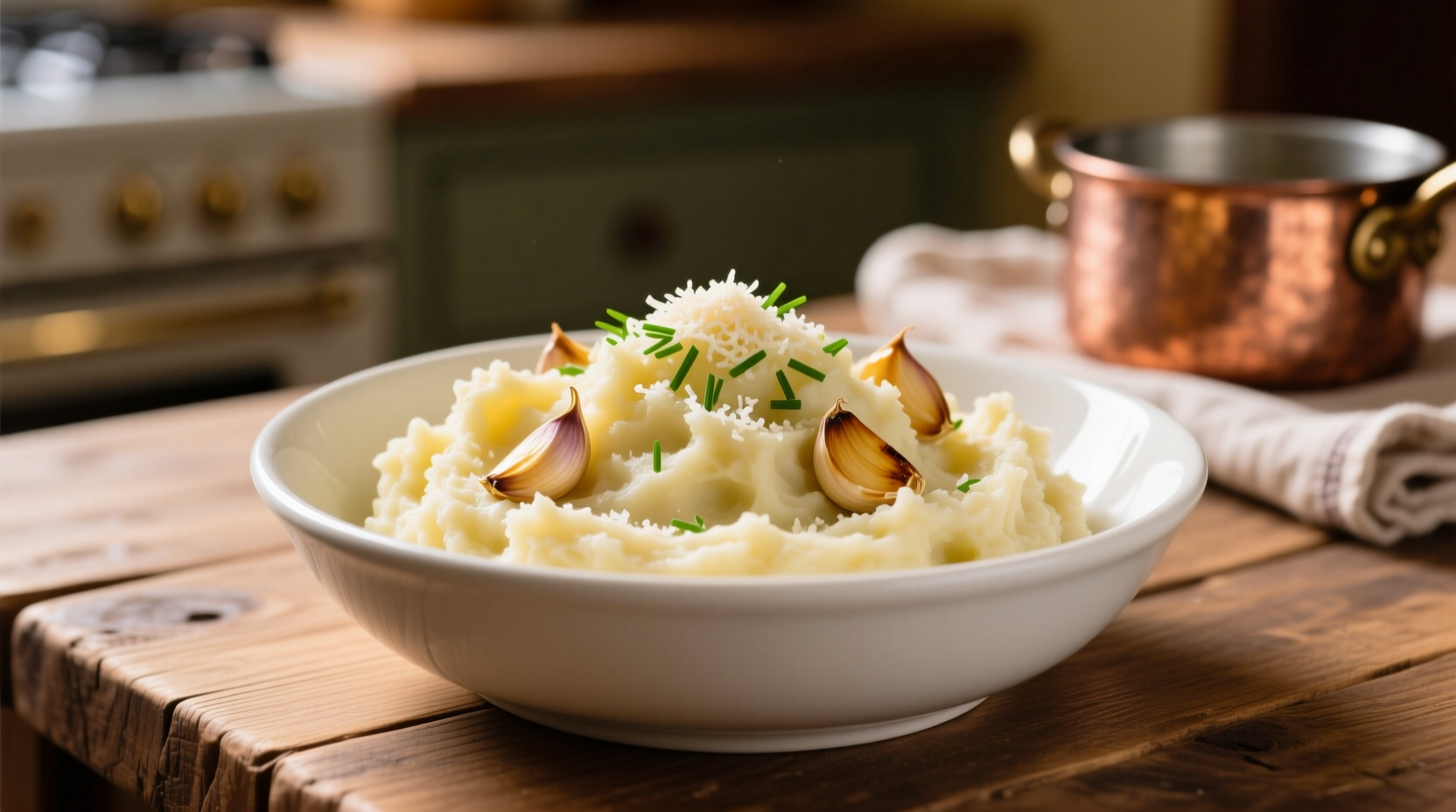Get perfectly creamy garlic mashed potatoes with sour cream every time with this professional-tested recipe. Our guide delivers restaurant-quality results with foolproof techniques, precise measurements, and science-backed tips to prevent lumps while maximizing garlic flavor. Ready in 35 minutes with common pantry ingredients.
Nothing beats the comforting richness of garlic mashed potatoes with sour cream, but achieving that perfect creamy texture without gluey lumps or weak garlic flavor can be tricky. As a culinary professional with years of experience perfecting classic comfort foods, I've developed this foolproof method that balances authentic flavor with reliable results. Whether you're preparing a holiday feast or weeknight dinner, this recipe delivers consistently smooth, flavorful mashed potatoes that impress every time.
Why This Garlic Mashed Potatoes Recipe Works
The magic happens through three key techniques: proper potato selection, controlled garlic infusion, and strategic dairy incorporation. Unlike many recipes that simply boil garlic with potatoes (resulting in muted flavor), our method uses a two-stage garlic approach—roasted for depth and fresh for brightness. The sour cream adds tangy richness while preventing the common pitfall of watery potatoes that occurs when using only milk or cream.
| Potato Variety | Starch Content | Best For Mashed Potatoes? | Texture Result |
|---|---|---|---|
| Russet (Idaho) | High (22-24%) | ✓ Ideal | Fluffy, light |
| Yukon Gold | Medium (18-20%) | ✓ Excellent | Creamy, buttery |
| Red Bliss | Low (15-17%) | ✗ Not Recommended | Dense, waxy |
| White Potatoes | Medium-High (20-22%) | ✓ Good | Smooth, slightly firm |
According to the Culinary Institute of America's food science research, potato starch content directly impacts texture. High-starch varieties like Russets absorb liquid better while maintaining structure during mashing—a critical factor for achieving that signature creamy-yet-defined texture in garlic mashed potatoes with sour cream.
Essential Ingredients Guide
Potatoes: Use 2.5 pounds (about 4-5 medium) Yukon Gold or Russet potatoes. Yukon Golds provide natural buttery flavor while Russets yield fluffier results. Always peel potatoes completely—skin fragments create unpleasant texture.
Garlic: 6 large cloves roasted plus 2 fresh minced cloves. Roasting mellows garlic's sharpness while developing complex sweetness. The fresh addition at the end preserves that signature garlic "kick" many recipes miss.
Dairy components: ½ cup whole milk heated with 4 roasted garlic cloves, 8 ounces full-fat sour cream, and 4 tablespoons unsalted butter. The USDA's Food Safety and Inspection Service confirms full-fat dairy provides superior emulsification for smooth texture.

Step-by-Step Preparation
- Prep potatoes: Peel and cut into uniform 1½-inch chunks. Immediately submerge in cold water to prevent browning.
- Roast garlic: Wrap 6 cloves in foil with 1 tsp olive oil. Bake at 400°F for 25 minutes until soft and golden.
- Cook potatoes: Drain potatoes and cover with cold water plus 1½ tsp salt. Bring to gentle boil, then reduce to simmer for 15-18 minutes until fork-tender.
- Heat dairy: Warm milk with 4 roasted garlic cloves to 160°F (do not boil). Remove cloves and mash into paste.
- Mash potatoes: Drain potatoes thoroughly. Return to pot over low heat for 1 minute to evaporate excess moisture. Add butter, then gradually incorporate warm milk mixture using potato masher (not mixer!) until just combined.
- Finish: Fold in sour cream and fresh minced garlic. Season with white pepper and additional salt if needed.
Avoid These Common Mistakes
- Over-mixing: Using electric mixers incorporates too much starch, creating gluey texture. Always mash by hand.
- Cold dairy: Adding cold ingredients causes potatoes to seize up. Warm all dairy components to at least 140°F.
- Insufficient seasoning: Potatoes need generous salt—about 1½ tsp per pound. Underseasoned potatoes taste flat regardless of other ingredients.
- Wrong potato variety: Waxy potatoes like red bliss won't achieve proper creaminess. Stick with high-starch options.
When to Choose Sour Cream Over Other Dairy Options
Sour cream provides unique benefits that make it ideal for garlic mashed potatoes in specific scenarios:
- Holiday meals: Its tangy richness cuts through heavy dishes like roast turkey or prime rib
- Cold-weather cooking: Higher fat content prevents separation when reheating leftovers
- Garlic-forward recipes: The acidity balances garlic's sharpness better than plain cream
- Make-ahead situations: Sour cream's stability maintains texture better than milk-based versions
However, avoid sour cream when serving with delicate fish dishes or when catering to dairy-allergic guests. In those cases, substitute with cashew cream or additional butter.
Serving Suggestions and Variations
Pair these garlic mashed potatoes with:
- Roasted chicken with herb jus
- Beef Wellington or prime rib
- Pan-seared salmon with lemon dill sauce
- Vegetarian mushroom Wellington
Dietary variations:
- Dairy-free: Substitute sour cream with coconut cream and use olive oil instead of butter
- Extra garlicky: Add 1 tsp garlic powder with the warm milk mixture
- Herb-infused: Fold in 2 tbsp chopped chives or parsley at the end
- Crispy topping: Transfer to baking dish, top with grated parmesan, and broil 2 minutes
Storage and Reheating Instructions
Store leftovers in airtight container in refrigerator for up to 4 days. For best results when reheating:
- Add 1-2 tbsp milk or cream per cup of potatoes
- Warm gently over low heat, stirring constantly
- Never microwave without additional liquid (causes separation)
- Finish with small pat of butter for renewed richness
Freezing is not recommended as sour cream separates during thawing. For meal prep, prepare through step 4 (heated milk mixture), then combine with freshly cooked potatoes when ready to serve.











 浙公网安备
33010002000092号
浙公网安备
33010002000092号 浙B2-20120091-4
浙B2-20120091-4